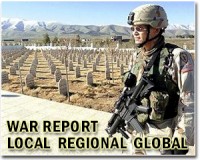| . |  |
. |
Tel Aviv, Israel (UPI) Dec 17, 2010 Despite torpedoing U.S. President Barack Obama's Middle East peace drive, Israel is still trying to sweet-talk Washington into providing 20 F-35 stealth fighters it promised free of charge in return for a settlements freeze in the occupied West Bank. Washington withdrew the offer after the government of Israeli Prime Minister Binyamin Netanyahu, dominated by right-wing parties, refused to extend a 10-month halt in settlement building for 90 days, the Palestinian condition for continuing the talks. In the face of Israel's refusal, the U.S. administration withdrew the offer of free F-35s worth $3 billion, along with other incentives it had put on the table. But Israeli officials say Netanyahu's government is still trying to work out a deal to get the 20 radar-evading, fifth-generation fighters that are built by Lockheed Martin. Last October, the Israelis agreed to buy 20 F-35s for $2.75 billion. But they have long sought to acquire 75 of the advanced aircraft, enough for three squadrons, to maintain Israel's military superiority. The 20 F-35s Israel is purchasing, with delivery scheduled for 2015-17, give the Israeli air force a formidable offensive capability in regional terms. Forty would give the Jewish state the means to deliver a destructive blow against its main adversary, Iran and its alleged drive to acquire nuclear weapons, by hitting multiple targets with virtual impunity. At a cost of around $110 million per aircraft, the Israelis have been seeking steep discounts from the Americans, who provide the Jewish state with $3 billion in military aid every year. Israel's outgoing chief of staff, Lt. Gen. Gabi Ashkenazi, said Nov. 17 during a visit to Washington that the Defense Ministry was driving for a concessionary price of around $96 million per aircraft. On top of U.S military aid, Israel gets billions of dollars more from Washington in grants and funding for joint projects. These include Israel Aerospace Industries' Arrow anti-ballistic missile and Rafael Advanced Defense Systems' Iron Dome, designed to shoot down short-range rockets. On Dec. 8, the U.S. Congress approved $205 million to pay for Israel's purchase of additional batteries of Iron Dome, a system critics claim isn't effective and is too expensive for what it may be able to achieve in countering massive missile attacks. One Israeli official noted that even before Obama put the freebie proposal on the table in November, Israel had been discussing ways to get a second batch of 30 F-35s with Washington. That came up when the Americans approached Israel to go along with a proposal to sell Saudi Arabia a package of advanced weapons systems worth more than $67 billion to bolster Arab forces against Iran. That will constitute the largest U.S. arms sale ever if the whole package is delivered. The Israelis, alarmed by Tehran's nuclear program, agreed to that after Washington assured them the Saudi package wouldn't include weapons that could threaten the Jewish state. "But nothing was settled" with regard to the F-35s, the official said in Tel Aviv. "We'll continue to discuss it." He indicated that Israel was still hoping it would not have to pay for the second batch of 20. Israeli Ambassador to the United Nations Michael Oren said in Washington that defense officials on both sides were discussing ways to pay for the additional F-35s because Israel doesn't have the funds to pay for them. One reason for that is the large amount of funds allocated to building up Israel's missile defense shield following the 2006 war against Hezbollah. During that 34-day conflict, the Iranian-backed group unleashed nearly 4,000 rockets against northern Israel, the heaviest bombardment the Jewish state has endured since it was founded in 1948. Politically, defending Israel's cities became the No. 1 priority and defense allocations were diverted from the air force and other military programs to pay for systems like Iron Dome. "It was clear from the beginning that the 20 (F-35s) we were purchasing would not be enough and we'd require more," Oren explained. Another problem is that the F-35 development phase is two years behind schedule and has involved massive cost overruns that have pushed up the price of the aircraft. At $392 billion, the F-35 is the most expensive U.S. weapons program ever. Deliveries to U.S. forces have been put back to 2015.
Share This Article With Planet Earth
Related Links
 EU, US hammer home plea for two-state solution
EU, US hammer home plea for two-state solutionBrussels (AFP) Dec 16, 2010 The European Union and the United States on Thursday issued a new plea to speed up progress towards a two-state solution encompassing a "viable" Palestine alongside a "secure" Israel. After meeting US Middle East envoy George Mitchell, on his way back from the region, EU foreign policy chief Catherine Ashton said: "We believe that urgent progress is needed towards a two-state solution ... th ... read more |
|
| The content herein, unless otherwise known to be public domain, are Copyright 1995-2010 - SpaceDaily. AFP and UPI Wire Stories are copyright Agence France-Presse and United Press International. ESA Portal Reports are copyright European Space Agency. All NASA sourced material is public domain. Additional copyrights may apply in whole or part to other bona fide parties. Advertising does not imply endorsement,agreement or approval of any opinions, statements or information provided by SpaceDaily on any Web page published or hosted by SpaceDaily. Privacy Statement |